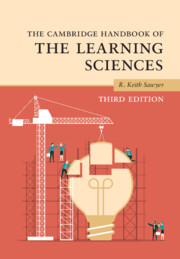Book contents
- The Cambridge Handbook of the Learning Sciences
- The Cambridge Handbook of the Learning Sciences
- Copyright page
- Contents
- Figures
- Tables
- Contributors
- Preface
- 1 An Introduction to the Learning Sciences
- Part I Foundations
- Part II Methodologies
- Part III Grounding Technology in the Learning Sciences
- 14 Video Games and Learning
- 15 Embodiment and Embodied Design
- 16 Tangible and Full-Body Interfaces in Learning
- 17 Augmented Reality in the Learning Sciences
- 18 Mobile Learning
- Part IV Learning Together
- Part V Learning Disciplinary Knowledge
- Part VI Moving Learning Sciences Research into the Classroom
- Index
- References
16 - Tangible and Full-Body Interfaces in Learning
from Part III - Grounding Technology in the Learning Sciences
Published online by Cambridge University Press: 14 March 2022
- The Cambridge Handbook of the Learning Sciences
- The Cambridge Handbook of the Learning Sciences
- Copyright page
- Contents
- Figures
- Tables
- Contributors
- Preface
- 1 An Introduction to the Learning Sciences
- Part I Foundations
- Part II Methodologies
- Part III Grounding Technology in the Learning Sciences
- 14 Video Games and Learning
- 15 Embodiment and Embodied Design
- 16 Tangible and Full-Body Interfaces in Learning
- 17 Augmented Reality in the Learning Sciences
- 18 Mobile Learning
- Part IV Learning Together
- Part V Learning Disciplinary Knowledge
- Part VI Moving Learning Sciences Research into the Classroom
- Index
- References
Summary
This chapter builds on growing trends such as the maker movement, programmable children’s toys like LEGO Mindstorms, and gaming consoles with movement sensors like the Nintendo Wii and the Microsoft Kinect. These technologies include fabrication and construction technologies such as 3D printers, laser cutters, and milling machines; embedded computing where small computational devices – such as motion sensors or LED lights – are inserted into physical artifacts; novel materials such as conductive threads or materials with shape memory; optics and tracking with cameras and GPS position sensing. In recent years, computing technologies have increased in power, decreased in cost, and become dramatically smaller. These features enable wearable devices that can be integrated with children’s crafts, tools, and playgrounds. The chapter reviews technologies including virtual reality, body augmentation, programmable toys like LEGO Mindstorms, and manipulatives that are responsive to body movement.
Keywords
- Type
- Chapter
- Information
- The Cambridge Handbook of the Learning Sciences , pp. 321 - 339Publisher: Cambridge University PressPrint publication year: 2022



